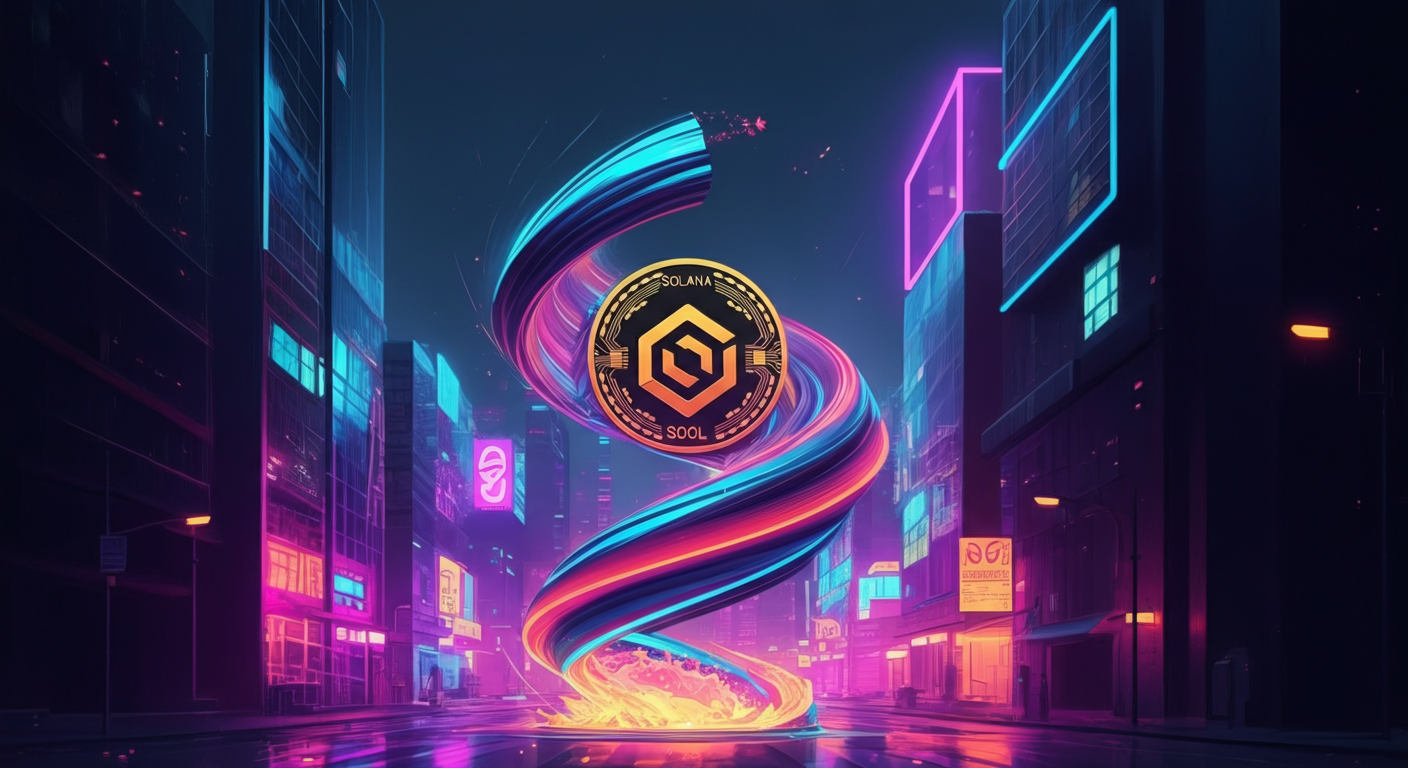Want a fast, cheap blockchain? Solana SOL is buzzing! Explore its tech, tokenomics, and potential in our beginner-friendly guide.#Solana #Blockchain #Crypto
🎧 Listen to the Audio
If you’re short on time, check out the key points in this audio version.
📝 Read the Full Text
If you prefer to read at your own pace, here’s the full explanation below.
Basic Info
John: Hey Lila, let’s dive into Solana SOL. It’s a blockchain project that’s been making waves in the crypto world. Think of it like a super-fast highway for digital transactions, where SOL is the fuel that keeps everything running smoothly.
Lila: That sounds exciting, John! So, what exactly is Solana SOL? I’ve seen it popping up a lot on X lately.
John: Solana is a high-performance blockchain platform designed to handle thousands of transactions per second without sacrificing decentralization or security. Its native cryptocurrency is SOL, used for paying fees, staking, and more. It’s like Ethereum but optimized for speed and low costs, making it great for apps like games or finance tools.
Lila: Cool! Can you break down its backstory? Like, how did it start?
John: In the past, Solana was founded in 2017 by Anatoly Yakovenko and his team at Solana Labs. They aimed to solve the blockchain trilemma—balancing speed, security, and decentralization. The mainnet launched in March 2020, right around the time when crypto was gaining mainstream attention. It drew inspiration from telecom tech, where Anatoly had experience at Qualcomm.
Lila: Interesting history. As of now, why are people talking about it so much?
John: As of now, Solana is buzzing because of its rapid growth in DeFi and NFTs. From what I’ve seen on X, the community is excited about recent updates like high transaction speeds hitting over 100,000 TPS in tests, and its price has been volatile but strong, around $183 USD as per recent market data. It’s also integrated with major players like Stripe for payments.
Lila: Wow, that speed is impressive! Looking ahead, what’s next for Solana?
John: Looking ahead, Solana plans to enhance its network with upgrades like Alpenglow for even faster finality—down to 150ms. Based on X discussions, there’s talk of more institutional adoption and expansions in Web3 apps, potentially rivaling traditional finance systems.

Core Technology / Features
Lila: John, let’s talk tech. What makes Solana’s foundation so special? Keep it simple for beginners like me!
John: Absolutely, Lila. At its core, Solana uses a unique consensus method called Proof of History (PoH), combined with Proof of Stake (PoS). PoH is like a clock that timestamps transactions, so the network doesn’t waste time agreeing on the order—it’s already sorted. This helps it scale massively.
Lila: Like a self-timing system? That’s neat. How does it handle scalability?
John: For scalability, Solana employs features like Tower BFT for quick consensus and Gulf Stream for mempool management, pushing transactions forward without delays. Imagine a busy airport where planes land every second instead of every minute— that’s Solana’s speed compared to slower blockchains.
Lila: Great analogy! Any special features?
John: One standout is its parallel processing with Sealevel, allowing multiple smart contracts to run at once, like having several checkout lines open at a store. It also has low fees, often under a penny per transaction, making it user-friendly.
Lila: In the past, how did these features develop?
John: In the past, Solana started with these innovations in 2020, facing some outages but iterating quickly. Early on, it processed 50,000 TPS in tests, setting it apart from Ethereum’s congestion issues.
Lila: As of now, how are they being used?
John: As of now, these features power a thriving ecosystem. Recent X posts from the Solana account highlight updates like the Block Assembly Marketplace by Jito, boosting compute limits by 20% and handling $1.6B in app inflows.
Lila: Looking ahead, any tech upgrades?
John: Looking ahead, expect improvements in latency with Alpenglow, reducing finality to 150ms, as mentioned by developers on X. This could enable real-time apps like instant trading or gaming.
Tokenomics / Supply Model
John: Tokenomics is key, Lila. SOL’s supply model is designed for sustainability. There’s no hard cap, but inflation decreases over time, starting at 8% and dropping to 1.5% long-term.
Lila: Like controlled money printing? Tell me about the past launch.
John: In the past, SOL launched via auctions and private sales in 2018-2020, raising funds for development. The initial supply was around 500 million, with tokens allocated to founders, investors, and the community.
Lila: As of now, how does the supply work?
John: As of now, the circulating supply is about 466 million SOL, with staking being huge—over 70% of tokens are staked, earning rewards while securing the network. Burning mechanisms, like fee burns, help control inflation.
Lila: Staking sounds rewarding. What’s planned for the future?
John: Looking ahead, the model aims for stability with ongoing inflation reduction. Community governance on X discusses proposals like SIMD 326 for better token management, potentially leading to more burns or incentives.

Use Cases & Ecosystem
Lila: John, what can people actually do with Solana?
John: Tons! In DeFi, platforms like Raydium offer lending and trading with low fees. For NFTs, it’s home to marketplaces like Magic Eden, where artists sell digital art quickly.
Lila: Business use too?
John: Yes, infrastructure for payments—Stripe integrates Solana for fast crypto payouts. Partnerships with firms like Franklin Templeton bring tokenized assets.
Lila: In the past, how did the ecosystem grow?
John: In the past, it exploded in 2021 with DeFi summer, surpassing $250M TVL on Raydium and tokenizing over $1B in assets, as per old X updates.
Lila: As of now, what’s happening?
John: As of now, the ecosystem includes projects like Backpack and SNS, with recent launches like M^0 for programmable stablecoins. X buzz shows apps generating $1.6B in value.
Lila: Looking ahead?
John: Looking ahead, more integrations in gaming and SocialFi, like Trends.fun tokenizing tweets, backed by Solana teams.
Developer Team & Community Engagement
John: The team at Solana Labs, led by Anatoly Yakovenko, has strong tech backgrounds from Qualcomm and Dropbox. They’re committed to open-source development.
Lila: How often do they update?
John: Updates are frequent—weekly highlights on X show constant shipments, like recent TPS records and governance processes.
Lila: Community energy?
John: Vibrant! X posts from @solana have hundreds of thousands of views, with AMAs and chats fostering engagement. It’s like a lively online neighborhood.
Lila: In the past?
John: In the past, community votes integrated projects like SushiSwap, building loyalty.
Lila: As of now?
John: As of now, governance on proposals like SIMD 326 shows active participation, with tools like SSR for tracking acquisitions.
Lila: Looking ahead?
John: Looking ahead, more decentralized governance and events like Breakpoint to boost engagement.
Rewards & Incentives (if applicable)
John: Solana offers staking rewards—lock your SOL to validate transactions and earn about 6-8% APY annually.
Lila: Other ways?
John: Yes, liquidity mining on DeFi apps like Raydium provides yields for providing liquidity. No central airdrops, but ecosystem grants for builders.
Lila: In the past?
John: In the past, staking helped secure the network post-launch, with early rewards attracting validators.
Lila: As of now?
John: As of now, high staking ratios show popularity, with updates enhancing rewards via better efficiency.
Lila: Looking ahead?
John: Looking ahead, potential new incentives through governance, like enhanced yields for long-term stakers.
Competitor Comparison
- Compared to Ethereum, which is like the OG blockchain but often slow and expensive, and Avalanche, known for subnets but with varying speeds.
- Solana stands out with its unmatched TPS and low costs, making it ideal for high-volume apps.
John: Why does Solana shine? Its PoH allows for blazing speed without sharding, unlike Ethereum’s approach.
Lila: True, and compared to Avalanche, Solana’s unified chain feels more seamless for developers.
John: Exactly, plus its energy efficiency—using far less power than proof-of-work chains like Bitcoin—makes it sustainable and appealing.
Risk Factors and Challenges
Lila: John, not all rosy—what are the risks?
John: Fair point. Security issues: Past hacks on wallets and a 2022 outage from DDoS attacks. Inflation risk from uncapped supply could dilute value if not managed.
Lila: Regulation?
John: Yes, SEC lawsuits allege SOL as a security, potentially bringing oversight. Network slowdowns have happened, though less now.
Lila: Sustainability?
John: As a PoS chain, it’s eco-friendly, but centralization concerns from validator concentration exist.
Lila: In the past?
John: In the past, multiple outages in 2021-2022 disrupted services, leading to community fixes.
Lila: As of now?
John: As of now, stability has improved, but regulatory scrutiny continues, as seen in recent filings.
Lila: Looking ahead?
John: Looking ahead, better decentralization and compliance could mitigate risks, but market volatility remains.
Industry Expert Insights
John: From X, analyst @ph0rt0n shared in a report: ‘Solana’s Q2 shows builders persisting, with institutional interest growing via Stripe and tokenized funds—it’s positioning as Ethereum’s fast alternative.’
Lila: Another one?
John: Developer @0xMert_ posted: ‘Alpenglow will slash latency to 150ms, an 80x improvement, unlocking real-time DeFi and apps—Solana’s speed edge is about to level up.’
Lila: In the past, now, ahead for insights?
John: In the past, experts noted early scalability wins; as of now, focus on resilience; looking ahead, optimism for mainstream adoption.
X Community Buzz & Roadmap Updates
Lila: What’s the buzz on X?
John: Huge excitement—posts from @solana highlight TPS records, BAM launches, and community governance. Trends like tokenizing tweets via Trends.fun are trending.
Lila: Roadmap?
John: Updates include Alpenglow for faster finality, more DeFi tools, and institutional frameworks. X discussions point to Breakpoint events for reveals.
Lila: In the past?
John: In the past, roadmaps focused on launches like Raydium integration.
Lila: As of now?
John: As of now, weekly snapshots show ongoing shipments and $1.6B inflows.
Lila: Looking ahead?
John: Looking ahead, governance acts and tech upgrades like compute boosts.

FAQ (minimum 6 questions)
What is Solana’s main advantage?
John: Its speed—handling thousands of transactions per second cheaply.
Lila: Yeah, like a sports car in the blockchain race!
How do I buy SOL?
John: Through exchanges like Binance or Coinbase, using fiat or other crypto.
Lila: Always use secure wallets!
Is Solana better than Ethereum?
John: It depends—faster and cheaper, but Ethereum has more history.
Lila: Solana’s great for quick trades!
What are SOL’s fees like?
John: Very low, often under $0.01 per transaction.
Lila: Cheaper than a coffee!
Can I stake SOL?
John: Yes, via wallets like Phantom for rewards.
Lila: It’s like earning interest on savings.
What’s the future of Solana?
John: More adoptions in finance and gaming.
Lila: Exciting times ahead!
Is Solana secure?
John: Generally yes, but past issues highlight vigilance.
Lila: DYOR always!
Related Links
Final Reflections
John: After exploring Solana SOL together, I can say it’s one of those projects that’s both interesting and approachable for newcomers.
John: It’s great to see how it blends innovation with a friendly, active community. I think it’s worth keeping an eye on!
Lila: Absolutely, John! I learned so much today. I love how blockchain projects like this can be explained without all the confusing jargon.
Lila: I’m looking forward to checking in on Solana SOL in the future to see how it grows!
Disclaimer: This article is for informational purposes only. Please do your own research (DYOR) before making any investment or usage decisions.
